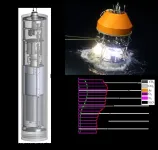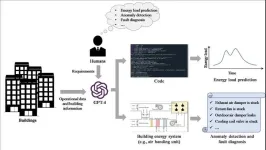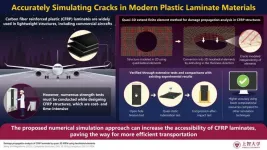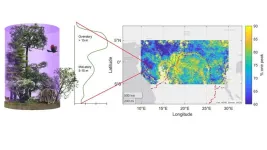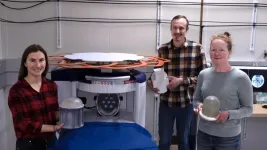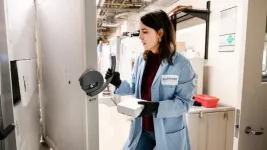The study is led by Prof. Chilai Chen (Hefei Institutes of Physical Science, Chinese Academy of Sciences).
The detection of dissolved gases in the deep sea is of great significance in exploring the origin and early evolution of life, understanding the interaction between the Earth's spheres, studying the geological profile of the Earth, searching for underwater oil, gas, and mineral resources, and researching global climate change. Changes in the concentrations of dissolved oxygen and nitrogen can indirectly or directly reflect the activity patterns of organisms such as plankton, phytoplankton, bacteria, and viruses in the deep sea. In situ detection of these changes is meaningful for studying biodiversity, especially in cold seeps and hydrothermal areas, which has special significance for the study of the origin of life. Typical greenhouse gases such as methane (CH4) and carbon dioxide (CO2) are important factors causing global warming. In the deep sea, they usually diffuse into the surrounding area in the form of bubbles or fluids. In situ detection of the gases is important for studying biogeochemical cycles, marine environments, and global climate change. Additionally, methane (CH4) is an important indicator for the detection of natural gas resources on the seabed.
The traditional method for detecting dissolved gases in the deep sea is offline detection, which combines pressure sampling with laboratory analysis. This method has the advantages of high detection accuracy and simultaneously detecting multiple substances. However, it has limitations in time and spatial resolution, making it difficult to perform continuous analysis of the temporal and spatial distribution of substances. An effective means of addressing this issue is online detection technology. Currently, the main underwater dissolved gas online detection technologies include electrochemical sensors based on gas-sensitive materials, various spectrometers based on optical measurement methods, and underwater mass spectrometers based on mass analyzers. Amongst these, electrochemical sensors have the advantages of small size, low power consumption, low cost, and the potential for large-scale deployment, making them highly promising in the field of deep-sea detection. However, their extensive use still requires further shortening of equipment response time, expanding the concentration detection range, and improving their anti-interference capabilities. Spectrometers based on optical measurement methods have small size and rapid characteristics and have developed rapidly in recent years. They have been successfully applied to the online detection of dissolved methane, carbon dioxide, and their isotopes in the ocean. The development of this technology provides a technical means for the detection of dissolved gases in the deep sea. However, this technology needs to further expand the types of detectable substances, shorten the detection time, and further improve the sustainable working time in the future.
Mass spectrometry is an analytical technique that works under vacuum conditions and is based on separating ions for their mass-to-charge ratios. Due to its advantages of fast response, low detection limit, high specificity, simultaneous detection of multiple substances, strong anti-interference ability, and ability to provide a large amount of elemental, structural, and isotopic information of chemical substances, it has been widely used in fields such as food safety, biomedical, environmental protection, and ecological health. The application of mass spectrometry to the in-situ online detection of dissolved gases in the deep sea is an important advancement in marine chemistry research.
Since its inception, deep-sea mass spectrometry has undergone more than 30 years of development. The world's first deep-sea mass spectrometer, a gas chromatography-mass spectrometer, was developed by the Hamburg University of Technology in Germany in 1998, primarily used for cleaning up chemical pollutants at sea. However, due to its complex detection process, long detection time, large volume, and challenges in meeting the requirements of underwater in-situ analysis, the development of this technology has been relatively limited.
In 1999 and 2001, the research team at the University of South Florida successively unveiled the first-generation deep-sea mass spectrometry based on quadrupole mass analyzers and the second-generation underwater mass spectrometry (UMS) based on ion trap mass analyzers. In the following five years, the team carried out instrument optimization and shallow water online detection work. They conducted experiments in Bayboro Harbor, plotted the three-dimensional concentration distribution maps of toluene and dimethyl sulfide, and obtained time-concentration curves of dissolved gases such as benzene, carbon dioxide, and argon in Lake Maggiore. In 2007, the team moved to RSI Company to continue deep-sea mass spectrometry research and successively obtained depth-concentration curves of carbon dioxide, methane, ethanol, and propane in deep-sea cold springs, hydrothermal areas, and other regions. They also conducted research on marine oil spills and the total inorganic dissolved carbon in the seabed.
The MIT underwater mass spectrometry research team publicly released their UMS based on a cycloidal mass analyzer in 2002. This device has a power consumption of 20 W, a weight of 25 kg, a detection time of less than 5 s, and can detect a mass range of 1–200 amu, with a maximum operating depth of 25 m. In principle, this UMS uses a double-focusing method based on electric and magnetic fields and a vacuum system based on an ion pump, which greatly improves the volume and weight of the equipment. Over the next five years, the team carried out underwater experiments and online detection work in shallow water areas. They obtained methane concentration distribution maps in the range of 0–25 m deep in Lake Superior and dissolved oxygen, dissolved nitrogen, and dissolved argon concentration distribution maps in the range of 0–5 m deep in Boston Harbor. In 2007, the Woods Hole Oceanographic Institution developed a new underwater mass spectrometer based on the work of the MIT team. This device has a weight of 13 kg, a maximum depth of over 5000 m, a mass detection range of 1–200 amu, a mass resolution of less than 0.1 amu, and a response time of less than 5 s. Based on this underwater mass spectrometer, they obtained concentration distribution maps of dissolved oxygen (O2), methane (CH4), and carbon dioxide (CO2) in the depth range of 0–350 m. Subsequently, they conducted related research work such as deep-sea oil exploration, pipeline leaks, and atmospheric circulation.
Apart from the two main research branches mentioned above, other institutions such as the University of Hawaii, Harvard University, and the Alfred Wegener Institute for Polar and Marine Research in Germany have also conducted research on underwater mass spectrometry. In 2005, engineers at the University of Hawaii's School of Ocean and Earth Science and Technology publicly released their first underwater mass spectrometer, and subsequently carried out more systematic instrument optimization and deep-sea in-situ detection work. The Alfred Wegener Institute released its first underwater mass spectrometer in 2008 and conducted deep-sea in-situ detection work. Harvard University released its first underwater mass spectrometer in 2010 and subsequently conducted research on the origin and early evolution of life, inter-layer interactions, and global environmental changes.
The work of the above research teams has made important contributions to the characteristics of deep-sea cold seeps and hydrothermal regions, exploring the origin and early evolution of life, studying the geological overview of the earth, searching for seabed resources, evaluating oil and gas and mineral resource reserves, analyzing the harm of pollution to the marine ecosystem, and studying global environmental changes. Overall, the research on UMS is still in the exploratory stage, and there are still many challenges to overcome. Currently, relevant research focuses on improving detection accuracy, reducing volume, and power consumption to achieve long-term, stable, and accurate detection in the deep sea.
UMS is still in its early stages in China, and no public reports are currently available. Based on previous research on the development of conventional mass spectrometry and atmospheric pressure ion mobility spectrometry technology, this study conducted research on underwater mass spectrometry. A breakthrough was made in high-pressure injection technology for underwater mass spectrometry, and vacuum maintenance technology under high-pressure and low-temperature environments, as well as long-term unmanned self-control technology, were developed to realize the miniaturization of high-precision underwater mass spectrometry technology and achieve online high-precision detection of small molecules and volatile organic compounds in seawater.
See the article:
Development and application of an underwater mass spectrometer for in situ detection of deep-sea dissolved gases
https://doi.org/10.1016/j.cjac.2023.100299
END
